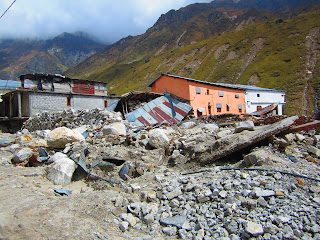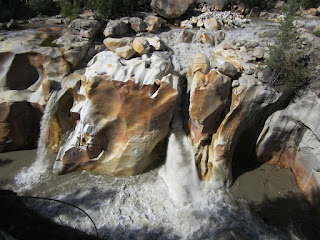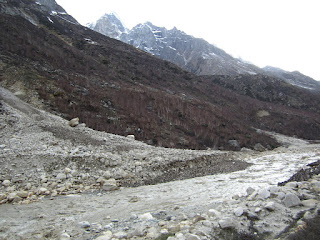Varanasi
– a city lost in time, a city where time stands still, the place where one
attains salvation - these are the epithets and odes that one usually hears when
the city is described. While these aren’t incorrect, Varanasi or Benaras is so
much more! Of course, these were the epithets that had drawn me to the city since long. Finally, an impromptu vacation idea led me to take a trip to Benaras.
Benaras is an experience that one must personally undergo in order to feel the vibrations of this mystical place. A day to day account of a trip in Benaras would do grave injustice to the experiences that I had during my travel here and so I have decided to give an account of my experiences here instead. Mornings are when one will truly be able to feel the vibrations of this city and I was fortunate to experience not one but 3 such enchanting mornings here.
Benaras is an experience that one must personally undergo in order to feel the vibrations of this mystical place. A day to day account of a trip in Benaras would do grave injustice to the experiences that I had during my travel here and so I have decided to give an account of my experiences here instead. Mornings are when one will truly be able to feel the vibrations of this city and I was fortunate to experience not one but 3 such enchanting mornings here.
The
moment I got rid of my baggage and entered the airport arena, the realization
that I was finally going to Benaras set in! In my excitement, I bought 2 Benarasi
silk stoles and then regretted it thinking that I was anyway going to Benaras
where I would get the same stuff at half at the price. My flight was made
miserable by a man who wanted to have sweet talk with a sour faced person like
me. He tried to sweetly draw my attention to how small things on the ground
looked like while we were high up in the air. I, on the other hand, pretended to be deep
asleep.
I
landed in Benaras and then got into the cab to my hotel. The airport road was
impressive and with malls and high rises everywhere, it felt nothing like an
ancient city. I must admit I was disappointed but then I realized the
selfishness concealed behind my disappointment. Every city has a right to
development. There was a lot of traffic on the way. I noticed something very
interesting. If a bike bumped into an auto rickshaw, the drivers of the 2
vehicles would just acknowledge each other and move on. Had it been Mumbai,
there would’ve been a brawl that would’ve held up traffic for a long time. This
was a feature that I would be noticing over the next few days in Benaras.
I
reached my hotel after an hour’s drive. As I carried myself and my luggage
upstairs, all I could think of was catching some sleep. My better half’s train
was getting delayed. He wouldn’t be there until another 4 hours. And so I dozed
off. I woke up with a start as it was quite dark and then I realized that I was
in the eastern part of India. It gets dark pretty early.
As
I lazily set out of my room, I first noticed the beauty of the guest house I
was in. The rooms were basic but the corridor of the guest house commanded an
excellent view of Assi Ghat. A “ghat” is an open area on the banks of a river that has a series of steps leading on to the river.
Standing there by the window, witnessing devotees go to and return from the ghat while sipping a cup of steaming chai was my idea of the perfect vacation. My better half arrived in some time and after an early dinner, we retired for the night.
MORNING 1
Standing there by the window, witnessing devotees go to and return from the ghat while sipping a cup of steaming chai was my idea of the perfect vacation. My better half arrived in some time and after an early dinner, we retired for the night.
MORNING 1
It
was 5 am in the morning when I was awoken by the Aarohan (ascent of musical notes) of Raag Bhairav. What
a wonderful morning call it was! I was almost startled having never expected it
at all! That was the moment that I realized that I was indeed in Benaras. Not
wasting any time, I quickly put on my shoes and rushed out with my camera.
Deepak had no clue as to why I was behaving thus but not wanting to miss out
anything that Benaras might have to offer, he followed me close behind. As we
reached the ghat, we were stunned to find a conglomeration of hundreds of
devotees. We soon realized that it was Chhat Puja or the worship of the Sun. Hundreds of
devotees were waiting for the sun to rise while I watched on speechless. As the
first rays of the sun reflected in the holy waters of the Ganga, hundreds of
hands went up in the air with their owners chanting “Har Har Mahadev”! In cue,
Deepak did the same while I stood there speechless again, the metro city girl
in me not knowing how to react. A couple of chants later, my arms lifted
themselves up a bit. The atmosphere was now electric. A few chants later, I
found myself one with the sea of devotees chanting “Har Har Mahadev”! All
devotees paid obeisance to the Sun that sustains all life on this Earth. I, for
one, remained spell bound by the way the morning had unfolded for me. There are some moments in life when words fail you, when your heart feels full. This morning was one such day. Benaras
had cast its spell on me.
EXCURSION TO KASHI VISHWANATH TEMPLE
EXCURSION TO KASHI VISHWANATH TEMPLE
Our
trip to the Kashi Vishwanath temple was enriching and funny as well. Like
soldiers on a mission, Deepak and I set out to visit the famous Jyotirlinga of
Lord Shiva determined to enter the shrine as commoners. As expected, we were
greeted by a queue of devotees. I immediately took my place but better wisdom
prevailed on Deepak as he suggested that we walk ahead and check where the
queue started from. We kept walking through the lanes. The queue was never ending.
After a long walk through winding lanes, we came to the mouth of the queue. A
policeman was guarding the entrance. If you were a foreigner and were carrying
a passport, you could skip the queue. But interestingly, the policeman told us
that if we had our passports, we could go through. I didn’t know I needed a
passport in my own country. But looking at the plight of devotees from West
Bengal, I thought I fared better. The policeman wouldn’t let them go without a
passport. He alleged that they could be illegal Bangladeshi immigrants!
Deepak
and I accepted defeat realizing that negotiating this queue was not our cup of
tea. We decided to return in the evening and get a VIP entry to the temple. On
our return to the main road though, we passed through various lanes that were nothing short of a maze. It is very easy to get lost in one of these winding lanes. There were vendors frying
savouries at every lane, vendors selling art curios, flower vendors, tea
stalls, mere onlookers and not to forget – The Holy Cow. The Holy Cow made her
presence felt at almost every lane. Not just pedestrians but riders on 2
wheelers also made way for her. She owned the lanes and moved without a care.
Some decided to sit and laze about right in the middle of a lane but no one
seemed to mind. In fact, as I was alighting from a “tuktuk”, a Holy Cow even
nudged me with her forehead on my elbow from behind as I was standing on her
way! Well, until now, I had only seen people clinging on to their cats and dogs
as their own kids. It was quite endearing to see people treating the cow with
reverence!
We
were back in the evening armed with a VIP pass to the Kashi Vishwanath temple
and in no time, we had entered the temple premises. We were now awaiting our
turn to enter the sanctum sanctorum. There was a television telecasting live the events unfolding inside the sanctum. Deepak and I observed, with deep amusement, devotees scrambling to get a good view of the Shiv lingam, pouring milk over
the lingam and then for a reason unknown to me, vigorously caressing the head
of the lingam. It led me to almost feel sorry for Shiva – imagine having
hundreds of people rubbing their hands over your head one after the other!
Perhaps, Shiva had temporarily left the sanctum. If any devotee’s devotion
lingered on for more than 30 secs, a priest, who would be sitting right across, flung a ladle full of milk on the devotee’s face. This left Deepak and me in
splits and we avoided each other’s eye to not break into hysteric laughter.
It
was our batch’s turn now to enter the sanctum. Once I was inside, though, it
felt different. I was there for probably only a minute, but that minute meant a
lot. I was wrong earlier. Some part of Shiva was definitely present there
patiently accepting the huge waves of devotees.
EXCURSION TO SARNATH
EXCURSION TO SARNATH
No
visit to Benaras is complete without a visit to Sarnath – one of the 4 holiest
pilgrimages for the Buddhists. This is where the Buddha first preached Dharma. Most
of the place is in ruins and, as most beautiful structures of ancient India,
were destroyed by barbarians in the form of Turks. These are times when I shudder to think about the amount of hatred and bigotry that is prevalent in the human race that would drive one to destroy beautiful pieces of art - art that is reminiscent of and a testimony to the greatness of the human race. The ancient relics, the ruins, the imposing Dhamek
stupa will transport you to a bygone era. The areas are spotlessly clean – a marvel
when you are travelling from Benaras.

The archaeological museum out there is another must visit place. It houses magnificent sculptures found during excavations at the archaeological site of Sarnath that date back to the 5th century. Most of these depict Hindu Gods and Goddesses mainly Shiva, Parvati, Ganesha. There are other sculptures depicting the Buddha in various forms.
On our return from Sarnath, we decided to visit the silk factory of Benaras. This is where Benarasi silk is actually woven! As we set out, we were greeted by a rhythmic sound that we later found out to emanate out of the weavers using their tool. Numerous maze like lanes, some dark and some lit only by a street light that seemed to be on its death bed, took us to an old dilapidated weaving factory where we witnessed the weaving of a silk saree.
MORNING 2 Benaras is a city that comes alive in the morning and is best explored in the early hours. So we first set out for a boat ride from Assi Ghat to Manikarnika Ghat. Hand paddled boats, although more expensive, will offer you a much more authentic experience. Looking at the condition of the boats, Deepak wasn’t too keen to board one. But I insisted. Reluctantly, he boarded the boat with me. As soon as I got on the boat, I noticed floating water. I didn’t want to start wondering now if this boat was filling with water and add to Deepak’s woes. However, as the boatman started paddling, Deepak noticed the same and tried to bring it to my notice. I reassured him that the boat wouldn’t overturn. My reassurance, however, seemed to have the opposite effect on him as he, clearly, had never thought about the possibilities of the boat over turning. Deepak kept mumbling to himself that the boat was filling with water while the boatman and I ignored him. Well, his mumblings didn’t have the intended effect on me and I had to stifle a laughter. The rest of the boat ride was mostly spent in silence. The morning was cloudy, and we didn’t get a sunrise. Nevertheless, I found the boat ride quite enchanting. Manikarnika Ghat is the much coveted place where the dead are cremated. While we were approaching this ghat, a couple of cremations were going on. It is said that one who passes away in Benaras, goes directly to Shiva's abode. It may seem weird that people specially come to this holy city to breathe their last, but death is only seen as a new beginning here.
On our way back from Manikarnika, we spotted the bloated bodies of a cow and a dog who may have been inadvertently wandering about the ghats at night and had probably slipped into the river. Although the bodies of the departed souls would be fished out soon, the idea of taking a "holy" dip in the river after this sight didn't quite agree with me. I'd rather live with my unwashed "sins", I decided.
We
alighted at Dashashwamedh Ghat and from there we could see the sun rising. After
a cup of tea there, we decided to take a hand pulled rickshaw to a temple. What
a wonderful experience that was! The time was just after dawn and as the
rickshaw pulled into the narrow streets, we heard beautiful shehnai playing all
along. It was not just a pleasant surprise. It was an explicable experience to
be out on the streets and not hear honking horns but pure Hinduatani classical
music! The memories of that morning are etched on my mind forever now. In fact, walking along the ghats will bring to your notice budding musicians holed up in corners and doing their morning riyaaz. While on a lazy stroll along the ghats in the mornings, I came across such musicians everyday.
THE SURPRISE EVENING
Our last evening at Benaras gave me an even bigger surprise. We were just wandering about from one ghat to the other when we stumbled upon Shivalik Ghat which was hosting a musical evening. Watching a musical performance in Benaras, I later realized, is in itself an experience. The crowd is extremely knowledgeable about ragas. It was an electric atmosphere as the crowd sang along to Kabir’s dohas while some burst onto impromptu dance routines. I have seen crowds swinging to rock music and Bollywood music, but never have I seen a crowd not just swinging to classical music but also singing along and cheering the musicians! I listened to some great music to my heart’s content. Good fortune had smiled at me more than once at Benaras. Benaras had left me captivated and spell bound for more reasons than one. Despite the filth, the pollution, the crowd, there’s something about this place that leaves a deep impression on you.
THE LAST DAY
On
our last day at Benaras, we checked out and since our train was late in the evening,
we decided to spend some time at the ghat. We found a comfortable bench and sat
there observing tourists and devotees go back and forth. There was a father who
bought a balloon for his child and just as the child held the string of the balloon,
the balloon soared upwards and got stuck high up on the branches of a banyan
tree. The child was dejected, the father bought her another balloon and they
left the area. No sooner had they left, another child who presumably lived in
one of the shanties near the ghat, came up with a game plan. He was carrying a
balloon too and now with this balloon he was going to try and fetch the balloon
that was stuck. Within a few minutes, the child had grabbed both Deepak and my
attention and we found ourselves discussing if and how the child would fetch
the balloon. The child kept going while Deepak and I were fervent in our
commentary and making inaudible suggestions such as “a little more to the left”,
“no! the balloon’s going to burst!”. Two hours passed by. The balloon was still
stuck there. The boy was going for a little break after which he, I am sure,
was going to resume his quest. It was time for us to leave.
At Benaras, there never is a dull moment!
At Benaras, there never is a dull moment!














































